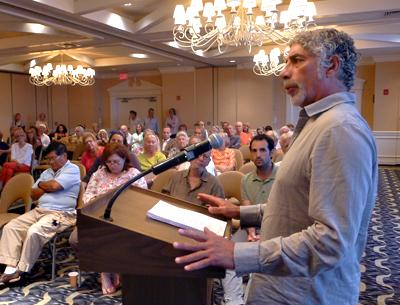Money Race Starts With a Whimper
Money Race Starts With a Whimper
In East Hampton Town, campaign contributions and campaign spending so far this year may be most notable not for what there is to report on, but for what there is not.
What’s missing are a Republican candidate for supervisor and, according to dueling complaints filed with the New York State Board of Elections late last month, an accurate accounting of campaign spending as of July 11 from one candidate and one political committee.
Campaign finance disclosure reports for the period ending July 11 were due with the board of elections on July 15.
Of the candidates for top posts, only Larry Cantwell, who has the town Democratic and Independence Party lines for supervisor, and Fred Overton, a Republican, Independence, and Conservative candidate for town board, filed detailed reports for the first half of the year. Mr. Overton’s running mate Councilman Dominick Stanzione filed a “no activity statement” for the period ending July 11, and both Kathee Burke-Gonzalez and Job Potter, the Democratic candidates for town board, reported no activity for the first half of 2013.
Christopher Kelley, the chairman of the Democrats’ campaign committee, Campaign 2013, has charged that Mr. Stanzione filed a false report because he failed to disclose contributions for the first half of the year and spending on ads that ran in local newspapers and on the Patch Web site in March, April, and June. “I guess he just abstained from filing,” Mr. Kelley joked. The councilman has come under frequent fire from his fellow G.O.P. board members as well as his Democratic opponents for too often abstaining on controversial votes.
Meanwhile, Carole Campolo, a Republican Committee member from Springs, has complained to the board of elections that Campaign 2013 failed to disclose spending on its own “numerous” print and radio ads.
Campaign 2013, the East Hampton Town Republican Committee, Pro East Hampton, another G.O.P. committee, and even the East Hampton Conservators, a deep-pocketed pro-Democratic political action committee, all reported negligible spending as of July 11.
Both Mr. Kelley and Mr. Stanzione, who was his own campaign treasurer, offered explanations. In Mr. Stanzione’s case, it was a mea culpa. “My bad,” he said in a release issued on Monday. He “acknowledged . . . that he made an honest mistake on his campaign report,” according to the release, and that the report “should have listed expenses associated with recent advertisements.” He has since hired a “professional treasurer” with the firm Campaigns Unlimited who is “making appropriate adjustments.”
“I’m not a campaign finance professional, that’s why I now have a professional handling the committee’s filings and finances,” Mr. Stanzione said. “I really appreciate that campaign finance and technical reporting is all best left to campaign professionals. Done well, it is time-consuming; done incorrectly it can be an unnecessary distraction from serving the people of our community — and that’s what I honestly believe I do best — serve.”
As of yesterday, a new report had not been filed. Mr. Stanzione is no longer the treasurer of his campaign committee.
In the Democrats’ case, Mr. Kelley said, the committee had not reported spending on the ads because it had not yet paid for them or been billed as of July 11. The East Hampton Star’s advertising manager, Min Spear, confirmed Tuesday that Campaign 2013 had not paid its advertising bill with this newspaper as of July 11.
As for the contributions and spending that were reported to the board of elections for the period ending July 11, Mr. Cantwell’s disclosure statement offered a glimpse at the range of his supporters.
Despite having no foreseeable opponent, he had brought in a hefty $62,999 since declaring his candidacy in mid-April and had spent $21,262 as of July 11.
The only other town candidate to raise more than $1,500, according to the disclosure reports, was Mr. Overton, the current town clerk, whose committee, Friends of Fred Overton, raised $11,490 as of July 11.
Mr. Cantwell got $1,000 contributions from 27 individuals and 2 corporations, and $500 contributions from 23 individuals and 4 corporations. Among his $1,000 backers are some, like Andy Sabin of Amagansett, who have traditionally thrown most of their contributions behind G.O.P. candidates. Mr. Cantwell, the recently retired East Hampton Village administrator, also had a number of prominent East Hampton Village homeowners among his top-dollar contributors. They included Donald Zucker and Barbara Zucker, Joanna Rose, Katharine J. Rayner, and Ina Garten.
Also contributing at the $1,000 level were Harvey J. Horowitz, Ralph Gibson, George Yates, Richard Michael Moran, Barbara H. Scheerer, and Patricia R. Handal, all of East Hampton; Janet C. Ross, Herbert S. Podell, Alexander M. Laughlin, and Judith W. Laughlin, all of East Hampton and New York, and Carl Vernick of Seaford and East Hampton. The big money also came from David N. Kelley of Sag Harbor, David Seeler of Amagansett, Michael Nuti, who lists a St. James address, Anthony A. Manheim of Brooklyn and Sagaponack, Annette P. Cumming and Ian M. Cumming of Jackson, Wyo., and East Hampton, Nicholas H. Racanelli of Brightwaters and Montauk, and Stanley Harris, Michael T. Bebon, and Thomas H. Lee, all listed with New York addresses.
He received $1,000 donations from two corporations — the law firm of Ackerman, O’Brien, Pachman, and Brown and Steven E. North P.C.
Mr. Cantwell’s $500 supporters included Rick White of Montauk, Harold McMahon of Amagansett, Augusta R. Folks of Shelter Island, and Kenneth M. Ferrin and Thaddeus J. Walkowicz of East Hampton. Those with East Hampton and New York addresses included Edward Bleier, Ron Delsener, Bruce Bozzi, Melville Straus, Alan Patricof, Joanna Grossman, David W. Laughlin, Suzanne Driscoll, Nancy Halis, and Andrew C. Right. Mr. Cantwell also got $500 contributions from Stuart Frankel of Boca Raton and East Hampton, Lawrence F. DiGiovanna of Brooklyn, George C. Bengston of Jupiter, Fla., and East Hampton, Frank Dalene of Wainscott, Maria E. Guercio of Farmingdale, and Harry Katz and Avron I. Brog, both of New York and Amagansett.
On the corporate side, his $500 backers were Keith Grimes Inc. of Montauk, Ironman Realty L.L.C. of New York, and D. Saatchi L.L.C.
His contributors, Mr. Cantwell said Monday, “represent a broad range of political views — Republicans, Democrats, businesspeople, environmentalists, people who just want a well-run town government.”
Friends of Larry Cantwell spent $21,262 as of July 11. Among that spending was $4,500 on polling with L.B.L. Consulting of East Hampton in March. He also paid L.B.L. another $5,500 for consulting, spent $3,923 on campaign literature, and paid Mullen and McCaffrey, a Springs communications firm, $4,500 for professional services.
He lent his campaign committee $5,000.
Andy Sabin was the biggest contributor to Friends of Fred Overton, contributing $1,000 to his campaign for town board. Mr. Overton received $500 contributions from Todd Sarris, a former East Hampton Town police chief, and Patrick G. Schutte and Stanley J. Arkin, both of Amagansett, Joe Bloecker and Ed Ecker Jr., the current police chief, both of Montauk, and from Wilkinson for Supervisor (Supervisor Bill Wilkinson’s campaign committee), and George Waldbridge Surveyors of East Hampton. He spent $3,171 as of July 11, mainly on a fund-raiser, radio ads, and a political consultant.
The Democrats’ Campaign 2013 raised $6,100 as of July 11, but reported as its only spending a $375 “in kind” contribution from David Gruber for radio ad production.
Patrick Bistrian Jr. Inc. and Bistrian Materials, both of East Hampton, were the only contributors to give $1,000 to Campaign 2013 during that period. The committee got $500 contributions from Richard Madan of East Hampton and Elizabeth de Cuevas of Amagansett and New York, and received a $1,500 transfer from the East Hampton Town Democratic Committee.
The Democratic Committee itself reported $14,472 in contributions for the first half of the year and $19,120 in spending. Clorinda Gorman of East Hampton, David Doty, and John Mullen each gave $1,000 to the committee. Mr. Cantwell gave $1,250. Janet C. Ross, Katherine J. Rayner, and David Gruber gave $500.
The committee repaid Zachary Cohen for loans in January ($3,000), April ($1,000), and May ($1,000). The committee also spent $4,070 on literature.
The East Hampton Town Republican Committee and East Hampton Independence Party did not file financial disclosure reports for the first half of the year.
The East Hampton Conservators reported little activity of interest in the first half of the year. It received $5,000 from Alec Baldwin and $2,500 from Marders Nursery in January, and spent $3,027. As of July 11, the Conservators had $30,974 in their account.







